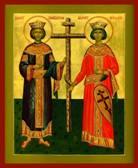Church History
Pages
Persecutions: St. Stephen
UNIT 4: PERSECUTION
Objective: Students should understand the historical and spiritual reasons for martyrdom, be able to name several martyrs (including the first), and know something about their lives, and to discuss the historical significance of Constantine the Great for both Rome and the Church.
WEEK 1: ST. STEPHEN
Definition of “Martyr”:
Persecutions: Martyrs
WEEK 2: MARTYRS
Persecutions: Constantine the Great
WEEK 3: CONSTANTINE THE GREAT
 While the teacher, or three of the students, read aloud the week’s lesson, have each of the other students jot down three good discussion or quiz questions for the discussion time.
While the teacher, or three of the students, read aloud the week’s lesson, have each of the other students jot down three good discussion or quiz questions for the discussion time.
The Political Situation
Early Church Fathers: Canon of Scripture
UNIT 5: THE EARLY CHURCH FATHERS
Objective: Students should be able to recite all the books of the Bible and have an understanding of what constitutes the canon of Scripture and how we got it, to recite the Nicene Creed and understand the positions of Arius and Athanasius at the Council of Nicea, and to list the parts of the liturgy of St. John Chrysostom and the objects used in the liturgy, understanding the life of St. John and his ministry.
Early Church Fathers: Council of Nicea
WEEK 2: COUNCIL OF NICEA
Early Church Fathers: St. John Chrysostom and the Liturgy
WEEK 3: ST. JOHN CHRYSOSTOM AND THE LITURGY
Life of St. John Chrysostom
St. John Chrysostom was born about 300 years after the time of Christ in the city of Antioch in the land of Syria. (Locate Antioch of Syria on your maps.) His parents, Secounthos and Anthousa, were very rich. They became Christians before John was born, and John was baptized when he was very young. Secounthos died when John was a boy, and Anthousa taught him carefully about Christ Jesus and the Christian life.
Church Established: Cappadocian Fathers, Macarius, and Ephraim
UNIT 6: THE CHURCH ESTABLISHED
Objective: Students should be able to identify several of the early church Fathers and understand their teachings, to discuss the development of monasticism and the monastic way of life, to identify and discuss the importance of such great monastics as St. Anthony the Great, St. Gregory Palamas, St. John Climacus, and St. Mary of Egypt, and to recite the Jesus Prayer.
Church Established: Monasticism
WEEK 2: MONASTICISM
Each of the men discussed last week was, at some point in his life, a monk. What is monasticism? Why would a man (or woman) leave their homes and lives and give up all property and the privilege of marriage and having children to become a monk?
Historic perspective:
Church Established: St. Gregory Palamas and St. John Climacus
WEEK 3: ST. GREGORY PALAMAS AND ST. JOHN CLIMACUS
Triodion:
Councils
UNIT 7: THE COUNCILS
Objective: Students should be able to give date and name to all seven councils, to name the major players in each and to understand the major debates and heresies, and to discuss the decisions reached and their importance.